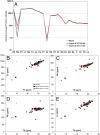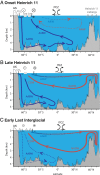Early Last Interglacial ocean warming drove substantial ice mass loss from Antarctica
- PMID: 32047039
- PMCID: PMC7049167
- DOI: 10.1073/pnas.1902469117
Early Last Interglacial ocean warming drove substantial ice mass loss from Antarctica
Abstract
The future response of the Antarctic ice sheet to rising temperatures remains highly uncertain. A useful period for assessing the sensitivity of Antarctica to warming is the Last Interglacial (LIG) (129 to 116 ky), which experienced warmer polar temperatures and higher global mean sea level (GMSL) (+6 to 9 m) relative to present day. LIG sea level cannot be fully explained by Greenland Ice Sheet melt (∼2 m), ocean thermal expansion, and melting mountain glaciers (∼1 m), suggesting substantial Antarctic mass loss was initiated by warming of Southern Ocean waters, resulting from a weakening Atlantic meridional overturning circulation in response to North Atlantic surface freshening. Here, we report a blue-ice record of ice sheet and environmental change from the Weddell Sea Embayment at the periphery of the marine-based West Antarctic Ice Sheet (WAIS), which is underlain by major methane hydrate reserves. Constrained by a widespread volcanic horizon and supported by ancient microbial DNA analyses, we provide evidence for substantial mass loss across the Weddell Sea Embayment during the LIG, most likely driven by ocean warming and associated with destabilization of subglacial hydrates. Ice sheet modeling supports this interpretation and suggests that millennial-scale warming of the Southern Ocean could have triggered a multimeter rise in global sea levels. Our data indicate that Antarctica is highly vulnerable to projected increases in ocean temperatures and may drive ice-climate feedbacks that further amplify warming.
Keywords: Antarctic ice sheets; marine ice sheet instability (MISI); paleoclimatology; polar amplification; tipping element.
Copyright © 2020 the Author(s). Published by PNAS.
Conflict of interest statement
The authors declare no competing interest.
Figures






References
-
- Ritz C., et al. , Potential sea-level rise from Antarctic ice-sheet instability constrained by observations. Nature 528, 115–118 (2015). - PubMed
-
- Golledge N. R., et al. , The multi-millennial Antarctic commitment to future sea-level rise. Nature 526, 421–425 (2015). - PubMed
-
- DeConto R. M., Pollard D., Contribution of Antarctica to past and future sea-level rise. Nature 531, 591–597 (2016). - PubMed
-
- Dutton A., et al. , Sea-level rise due to polar ice-sheet mass loss during past warm periods. Science 349, aaa4019 (2015). - PubMed
-
- Mercer J. H., West Antarctic Ice Sheet and CO2 greenhouse effect: A threat of disaster. Nature 271, 321–325 (1978).
Publication types
LinkOut - more resources
Full Text Sources

